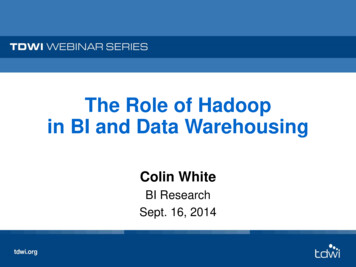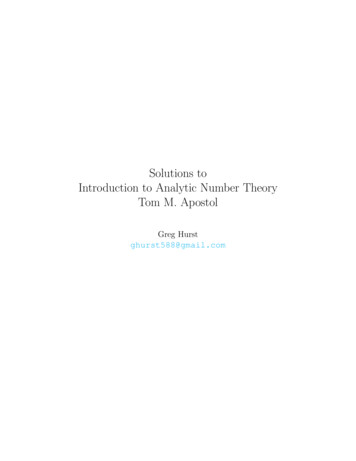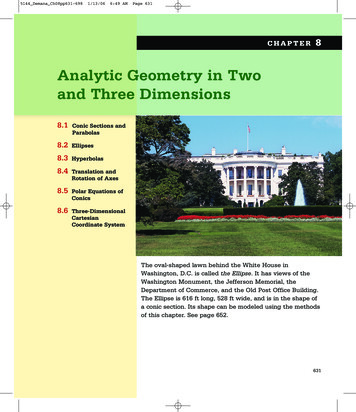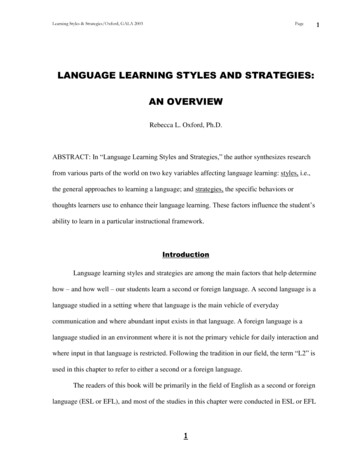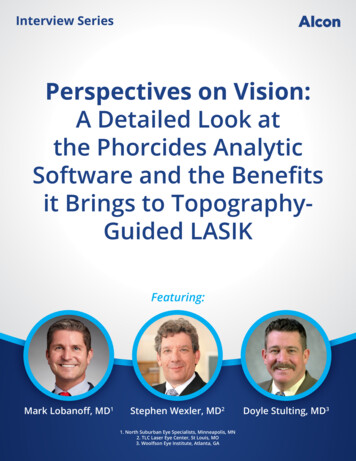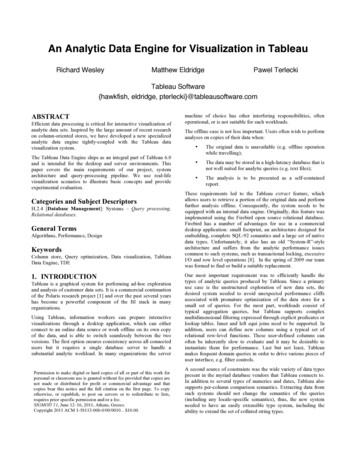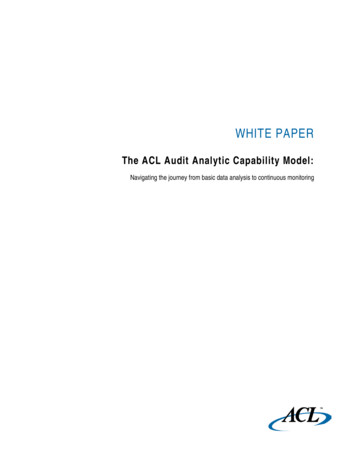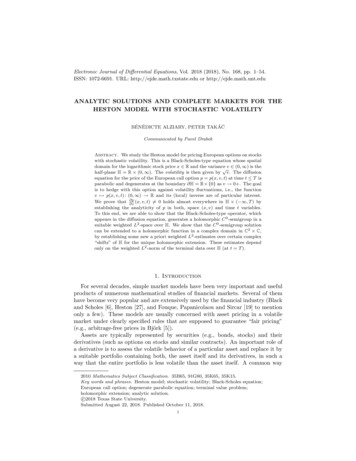
Transcription
Electronic Journal of Differential Equations, Vol. 2018 (2018), No. 168, pp. 1–54.ISSN: 1072-6691. URL: http://ejde.math.txstate.edu or http://ejde.math.unt.eduANALYTIC SOLUTIONS AND COMPLETE MARKETS FOR THEHESTON MODEL WITH STOCHASTIC VOLATILITYBÉNÉDICTE ALZIARY, PETER TAKÁČCommunicated by Pavel DrabekAbstract. We study the Heston model for pricing European options on stockswith stochastic volatility. This is a Black-Scholes-type equation whose spatialdomain for the logarithmic stock price x R and the variance v (0, ) is the half-plane H R (0, ). The volatility is then given by v. The diffusionequation for the price of the European call option p p(x, v, t) at time t T isparabolic and degenerates at the boundary H R {0} as v 0 . The goalis to hedge with this option against volatility fluctuations, i.e., the functionv 7 p(x, v, t) : (0, ) R and its (local) inverse are of particular interest. pWe prove that v(x, v, t) 6 0 holds almost everywhere in H ( , T ) byestablishing the analyticity of p in both, space (x, v) and time t variables.To this end, we are able to show that the Black-Scholes-type operator, whichappears in the diffusion equation, generates a holomorphic C 0 -semigroup in asuitable weighted L2 -space over H. We show that the C 0 -semigroup solutioncan be extended to a holomorphic function in a complex domain in C2 C,by establishing some new a priori weighted L2 -estimates over certain complex“shifts” of H for the unique holomorphic extension. These estimates dependonly on the weighted L2 -norm of the terminal data over H (at t T ).1. IntroductionFor several decades, simple market models have been very important and usefulproducts of numerous mathematical studies of financial markets. Several of themhave become very popular and are extensively used by the financial industry (Blackand Scholes [6], Heston [27], and Fouque, Papanicolaou and Sircar [19] to mentiononly a few). These models are usually concerned with asset pricing in a volatilemarket under clearly specified rules that are supposed to guarantee “fair pricing”(e.g., arbitrage-free prices in Björk [5]).Assets are typically represented by securities (e.g., bonds, stocks) and theirderivatives (such as options on stocks and similar contracts). An important role ofa derivative is to assess the volatile behavior of a particular asset and replace it bya suitable portfolio containing both, the asset itself and its derivatives, in such away that the entire portfolio is less volatile than the asset itself. A common way2010 Mathematics Subject Classification. 35B65, 91G80, 35K65, 35K15.Key words and phrases. Heston model; stochastic volatility; Black-Scholes equation;European call option; degenerate parabolic equation; terminal value problem;holomorphic extension; analytic solution.c 2018 Texas State University.Submitted August 22, 2018. Published October 11, 2018.1
2B. ALZIARY, P. TAKÁČEJDE-2018/168to achieve this objective is to add a derivative on the volatile asset to the portfoliocontaining this asset. This procedure, called hedging, is closely connected withthe problem of market completion (Davis [10]), Romano and Touzi [48]). Therehave been a number of successful attempts to obtain a market completion by (callor put) options on stocks. The pricing of such options involves various kinds ofthe Black-Scholes-type equations. These attempts are typically based on probabilistic, analytic, and numerical techniques, some of them including even explicitformulas, cf. Achdou and Pironneau [1, Chapt. 2]. The basic principle behind allBlack-Scholes-type models is that the model must be arbitrage-free, that is, anyarbitrage opportunity must be excluded which is possible only if there exists anequivalent probability measure such that the option price is a stochastic processthat is a martingale under this measure (in which case it is called a martingalemeasure, cf. Björk [5, §3.3, pp. 32–33]). Itô’s formula then yields an equivalent linear parabolic equation which will be the object of our investigation, cf. Davis [10].Throughout our present work we study the Heston model of pricing for Europeancall options on stocks with stochastic volatility (Heston [27]) by abstract analyticmethods coming from partial differential equations (PDEs, for short) and functionalanalysis. Without any option, derivative, or other contingent claim added to theHeston model, this model represents an incomplete market. In probabilistic terms,this means that the martingale measure mentioned above is possibly not unique.We use a PDE to give a rigorous analytic formulation of Heston’s model in the nextsection (Section 2). Our main results are presented in a functional-analytic settingin Section 4.In our simple market, described by the Heston stochastic volatility model (Hestonmodel, for short), market completion by a European call option on the stock hasthe following meaning: The basic quantities are the maturity time T (called alsothe exercise time), 0 T , at which the stock option matures; the real timet, t T ; the time to maturity τ T t 0, 0 τ ; the spotprice of stock St (St 0) and the (stochastic) variance of the stock market Vt(Vt 0) at time t T ; Vt is associated with the (stochastic) volatility of thestock market; the strike price (exercise price) K const 0 of the stock optionat maturity, a European call or put option; a given (nonnegative) payoff functionĥ(ST , VT ) (ST K) at time t T (i.e., τ 0) for a European call option;and the (call or put) option price Pt U (St , Vt , t) 0 at time t, given the stockprice St and the variance Vt . In the derivation of Heston’s model [27], which is asystem of two stochastic differential equations for the pair (St , Vt ), Itô’s formulayields a diffusion equation for the unknown option price Pt U (St , Vt , t) 0 attime t which depends only on the stock price St and the variance Vt at time t.This allows us to replace the relative logarithmic stock price Xt ln(St /K), astochastic process valued in R ( , ), and the variance Vt , another stochasticprocess valued in (0, ), respectively, by a pair of (independent) space variables(x, v) valued in the open half-plane H : R (0, ) R2 . Consequently, theoption price Pt p(Xt , Vt , t) : U KeXt , Vt , t is a stochastic process whose valuesat time t (t T ) are determined by the values of (Xt , Vt ). Its terminal value, PTat maturity time t T , is given byPT p(XT , VT , T ) K eXT 1 (ST K) for (XT , VT ) H.
EJDE-2018/168ANALYTIC SOLUTIONS AND COMPLETE MARKETS3The well-known arbitrage-free option pricing (Björk [5, Chapt. 7, pp. 92–108]) thenyields the expectation formula p(x, v, t) K · e r(T t) EP eXT 1 Xt x, Vt v(1.1)for (x, v) H and t ( , T ]; see, e.g., Fouque, Papanicolaou, and Sircar [19,§2.4–2.5, pp. 42–48]. In particular, the terminal condition at t T is fulfilled,p(x, v, T ) K (ex 1) for (x, v) H.(1.2)The option price p p(x, v, t) pτ (x, v), where τ T t 0, is determined byan equivalent, risk neutral martingale measure [10, 48], which yields the stochasticprocess (Pt )0 t T . This measure is unique if and only if every contingent claim canbe replicated by a self-financed trading strategy using bond, stock, and option; thatis to say, if and only if the option price (Pt )0 t T completes the market ( Harrisonand Pliska [24, 25]). Applying Itô’s formula to this process, one concludes that,equivalently to the probabilistic expectation formula (1.1) for p(x, v, t), this optionprice can be calculated directly from a partial differential equation of parabolictype with the terminal value condition (1.2). Thus, given the (relative logarithmic)stock price x R at a fixed time t ( , T ], the function p̃x,t : v 7 p(x, v, t) yieldsthe (unique) option price for every v (0, ). According to Bajeux-Besnainouand Rochet [3, p. 12], the characteristic property of a complete market is thatp̃x,t : (0, ) R is injective (i.e., one-to-one), which means that any particularoption value p p̃x,t (v) cannot be attained at two different values of the variancev (0, ). We take advantage of this property to give an alternative definition ofa complete market using differential calculus rather than probability theory, see ourDefinition 5.3 in Section 5. This is a purely mathematical problem that we solve inthis article for the Heston model by analytic methods, with a help from [3, Sect. 5]and the work by Davis and Oblój [11]; see Section 5 below, Theorem 5.2. We referthe reader to the monograph by Delbaen and Schachermayer [12] for an up-todate treatment of complete markets with no arbitrage opportunity (particularly inChapter 9, pp. 149–205).There are several other stochastic volatility models, see, e.g., those listed in[19, Table 2.1, p. 42] and those treated in [19, 31, 42, 49, 54], that are alreadyknown to allow or may allow market completion by a European call or put option.However, the rigorous proofs of market completeness (and their methods) vary frommodel to model; cf. Björk [5]. Some of them are more probabilistic (Anderson andRaimondo [2] with “endogenous completeness” of a diffusion driven equilibriummarket, Bajeux-Besnainou and Rochet [3], Hugonnier, Malamud, and Trubowitz[29], Kramkov and Predoiu [37], and Romano and Touzi [48]), others more analytic(PDEs), e.g., in Davis [10], Davis and Oblój [11], and Takáč [52].In the derivation of Heston’s model [27], Itô’s formula yields the following diffusion equation (in Heston’s original notation) A U (s, v, t) 0 tfor s 0, v 0, t T.(1.3)The variables s and v, respectively, stand for the values of the stochastic processes(St )t 0 and (Vt )t 0 at a time t 0 on a (continuous) path ω : [0, ) (0, )2(that belongs to the underlying probabilistic space Ω), i.e., s St (ω) 0 andv Vt (ω) 0. We call A the Black-Scholes-Itô operator for the Heston model; it
4B. ALZIARY, P. TAKÁČEJDE-2018/168is defined by(AU )(s, v, t) 1 2U 2U1 2U: v ·s2 2 (s, v, t) ρσs(s, v, t) σ 2 2 (s, v, t)2 s s v2 v U U(s, v, t) [κ(θ v) λ(s, v, t)](s, v, t) (r q)s s v rU (s, v, t) for s 0, v 0, and t T ,(1.4)with the following additional quantities (constants) as given data: the risk freerate of interest r R; the dividend yield q R; the instantaneous drift of thestock price returns r q qr R (when interpreted under the original, “real -world” probability measure); the volatility σ 0 of the stochastic volatility v;the correlation ρ ( 1, 1) between the Brownian motions for the stock price andthe volatility; the rate of mean reversion κ 0 of the stochastic volatility v; thelong term variance θ 0 (called also long-run variance or long-run mean level )of the stochastic variance v; and the price of volatility risk λ(s, v, t) 0, in [27]chosen to be linear, λ(s, v, t) λv with a constant λ const 0.We assume a constant risk free rate of interest r and a constant dividend yieldq; hence, r q qr is the instantaneous drift of the stock price returns (underthe original probability measure); All three quantities, r, q, and qr , may take anyreal values; but, typically, one has 0 r q whence also qr 0. We referthe reader to the monograph by Hull [30, Chapt. 26, pp. 599–607] and to Heston’soriginal article [27] for further description of all these quantities.The diffusion equation (1.3) is supplemented first by the following dynamicboundary condition as v 0 , B U (s, 0, t) 0 tfor s 0, t T.(1.5)The boundary operator B is the trace of the Black-Scholes-Itô operator A as v 0 ; it corresponds to the Black-Scholes operator with zero volatility:(BU )(s, 0, t) : (r q)s U U(s, 0, t) κθ(s, 0, t) rU (s, 0, t) s v(1.6)for s 0, v 0, and t T .The original Heston boundary conditions in [27],U (0, v, t) 0for v 0; (U (s, v, t) s) 0 for v 0; slim (U (s, v, t) s) 0 for s 0,lims (1.7)v at all times t ( , T ), seem to be “economically” motivated. Mathematically,one may attempt to motivate them by the asymptotic behavior of the solutionUBS (s, t) UBS (s, v0 , t) to the Black-Scholes equation, for s 0 and t T , wherethe variance v0 σ02 0 is a given constant determined from the constant volatility
EJDE-2018/168ANALYTIC SOLUTIONS AND COMPLETE MARKETS5σ0 0. What we mean are the following boundary conditions,UBS (0, v, t) 0 for v 0; (UBS (s, v, t) s) 0 for v 0;s slim (UBS (s, v, t) s) 0 for s 0,lim(1.8)v at all times t ( , T ). Roughly speaking, the difference U (s, v, t) UBS (s, v, t)becomes asymptotically small near the boundary, and so does its s-partial derivativeas s . The terminal condition as t T for both solutions, U and UBS , isthe payoff function ĥ(s, v) (s K) for s 0,U (s, v, T ) UBS (s, v, T ) (s K) .The solution UBS (s, t) of the Black-Scholes equation has been calculated explicitly in the original article by F. Black and M. Scholes [6]; see also Fouque,Papanicolaou, and Sircar [19, §1.3.4, p. 16].Finally, the diffusion equation (1.3) is supplemented also by the following terminal condition as t T , which is given by the payoff function ĥ(s, v) (s K) ,U (s, v, T ) (s K) for s 0, v 0.(1.9)We would like to point out that, by our mathematical approach, we are able to treatmuch more general terminal conditions U (s, v, T ) u0 (s, v) for s 0, v 0; seeProposition 4.1 and Theorem 4.2 in Section 4 below, where u0 H – a weighted L2 type Lebesgue space. Hence, we are not restricted to European call options (1.9).The terminal-boundary value problem for (1.3) with the boundary conditions (1.5)and (1.7), as it stands, poses a mathematically challenging problem, in particular,due to the degeneracies in the diffusion part of the operator A: Some or all of thecoefficients of the second partial derivatives tend to zero as s 0 and/or v 0 ,making the diffusion effects disappear on the boundary {(s, 0) : s 0}, cf. eq. (1.6).Similar questions concerned with terminal and boundary conditions are addressedin Ekström and Tysk [13]. However, their work treats only smooth solutions withonly smooth terminal data and, thus, excludes the (very basic) European call andput options.This article is organized as follows. We begin with a rigorous mathematical formulation of the Heston model in Section 2. We make use of weighted Lebesgueand Sobolev spaces originally introduced in Daskalopoulos and Feehan [8] and [9,Sect. 2, p. 5048] and Feehan and Pop [17]. An extension of the problem from thereal to a complex domain is formulated in Section 3. Our main results, Proposition 4.1 and Theorem 4.2, are stated in Section 4. Before giving the proofs of thesetwo results, in Section 5 we present an application of them to Heston’s model [27]for European call options in Mathematical Finance. There we also provide an affirmative answer (Theorem 5.2) to the problem of market completeness as describedin Davis and Oblój [11]. Our contribution to market completeness is also an alternative definition for a market to be complete (Definition 5.3) which is based onclassical concepts of differential calculus ( Bajeux-Besnainou and Rochet [3, p. 12])rather than on probability theory. In addition, we discuss the important Feller condition in Remark 5.4 and also mention another application to a related model inRemark 5.5. The proofs of our main results from Section 4 are gradually developedin Sections 6 through 8 and completed in Section 9. Finally, Appendix 10 containssome technical asymptotic results for functions from our weighted Sobolev spaces,
6B. ALZIARY, P. TAKÁČEJDE-2018/168whereas Appendix 11 is concerned with the density of certain analytic functions inthese spaces.2. Formulation of the mathematical problemIn this section we introduce Heston’s model [27, Sect. 1, pp. 328–332] and formulate the associated Cauchy problem as an evolutionary equation of (degenerate)parabolic type.2.1. Heston’s stochastic volatility model. We consider the Heston model givenunder a risk neutral measure via equations (1) (4) in [27, pp. 328–329]. Themodel is defined on a filtered probability space (Ω, F, (Ft )t 0 , P), where P is a riskneutral probability measure, and the filtration (Ft )t 0 satisfies the usual conditions.Recalling that St denotes the stock price and Vt the (stochastic) variance of thestock market at (the real) time t 0, the unknown pair (St , Vt )t 0 satisfies thefollowing system of stochastic differential equations,pdSt qr dt Vt dWt ,St(2.1)pdVt κ(θ Vt )dt σ Vt dZt ,where (Wt )t 0 and (Zt )t 0 are two Brownian motions with the correlation coefficient ρ ( 1, 1), a constant given by dhW, Zit ρdt. This is the original Hestonsystem in [27].If Xt ln(St /K) denotes the (natural) logarithm of the scaled stock price St /Kat time t 0, relative to the strike price K 0, then the pair (Xt , Vt )t 0 satisfiesthe following system of stochastic differential equations, p1 dXt qr Vt dt Vt dWt ,2(2.2)pdVt κ(θ Vt )dt σ Vt dZt .Following [11, Sect. 4], let us consider a European call option written in thismarket with payoff ĥ(ST , VT ) ĥ(ST ) 0 at maturity T 0, where ĥ(s) (s K) for all s 0. As usual, for x R we abbreviate x : max{x, 0}and x : max{ x, 0}. Recalling Heston’s notation in (1.3) and (1.4), we denotex Xt (ω) R. We set h(x, v) h(x) K(ex 1) for all x ln(s/K) R, sothat h(x) ĥ(s) ĥ(Kex ) for x R. Hence, if the instant values (Xt (ω), Vt (ω)) (x, v) H are known at time t (0, T ), where H R (0, ) R2 , the arbitrage-free price Pth of the European call option at this time is given by the followingexpectation formula (with respect to the risk neutral probability measure P) whichis justified in [11] and [52]: Pth p(Xt , Vt , t) wherep(x, v, t) e r(T t) EP [ĥ(ST ) Ft ] e r(T t) EP [h(XT ) Ft ] e r(T t) EP [h(XT ) Xt x , Vt v].Furthermore, p solves the (terminal value) Cauchy problem p Gt p rp 0 , (x, v, t) H (0, T ); tp(x, v, T ) h(x) , (x, v) H ,(2.3)(2.4)with Gt being the (time-independent) infinitesimal generator of the time-homogeneous Markov process (Xt , Vt ); cf. Friedman [21, Chapt. 6] or Øksendal [46,
EJDE-2018/168ANALYTIC SOLUTIONS AND COMPLETE MARKETS7Chapt. 8]. Indeed, first, equation (1.3) is derived from (2.2) and (2.3) by Itô’sformula, then the diffusion equation (2.4) is obtained from (1.3) usings Kex ,ds s,dx U p(x, v, t) s(s, v, t) , x s2 2p U2 U(x,v,t) s(s, v, t)(s,v,t) s x2 s s2 p 2U (x, v, t) s2 2 (s, v, t) . x sp(x, v, t) U (s, v, t) ,Hence, the function p : (x, v, t) 7 p(x, v, T t) satisfies a linear Cauchy problem ofthe following type, with the notation x (x1 , x2 ) (x, v) H,22XX 2p p paij (x, t) bj (x, t) c(x, t)p t i,j 1 xi xj j 1 xj f (x, t)(2.5)for (x, t) H (0, T );p(x, 0) u0 (x)for x H ,with the function f (x, t) 0 on the right-hand side (which may become nontrivial inrelated Cauchy problems later on), the initial data u0 (x) u0 (x, v) p(x, v, T ) h(x) at t 0, and the coefficients v 1 ρσa(x, v, t) R2 2sym ,2 ρσ σ 2 qr 12 v R2 , c(x, v, t) r R ,b(x, v, t) κ(θ v) λ(x, v, T t)where the variable x (x1 , x2 ) R2 has been replaced by (x, v) H R2 . Wehave also replaced the meaning of the temporal variable t as real time (t T )by the time to maturity t (t 0), so that the real time has become τ T t.According to Heston [27, (6), p. 329], the unspecified term λ(x, v, T t) in thevector b(x, v, t) represents the price of volatility risk and is specifically chosen tobe λ(x, v, T t) λv with a constant λ 0. As we have already pointed out inthe Introduction (Section 1), we can treat much more general terminal conditionsu0 (x) u0 (x, v) p(x, v, T ) h(x, v) than just those corresponding to a Europeancall option, p(x, v, T ) h(x) K(ex 1) for (x, v) H; see Section 4 below.In particular, we do not need the convexity of the function h(x) K(ex 1) ofx R used heavily in Romano and Touzi [48].Next, we eliminate the constants r R and λ 0, respectively, from (2.5) bysubstitutingp (x, v, t) : e r(T t) p(x, v, t) e r(T t) p(x, v, T t)for p(x, v, t) ,(2.6)which is the discounted option price, and replacing κ by κ κ λ 0 and θκθby θ κ λ 0. Hence, we may set r λ 0. Finally, we introduce also there-scaled variance ξ v/σ 0 for v (0, ) and abbreviate θσ : θ/σ R. Thesesubstitutions will have a simplifying effect on our calculations later. Equation (2.5)then yields the following initial value problem for the unknown function u(x, ξ, t)
8B. ALZIARY, P. TAKÁČEJDE-2018/168p (x, σξ, t): u Au f (x, ξ, t) in H (0, T ); tu(x, ξ, 0) u0 (x, ξ) for (x, ξ) H ,(2.7)with the function f (x, ξ, t) 0 on the right-hand side and the initial data u0 (x, ξ) h(x) at t 0, where the (autonomous linear) Heston operator A, derived from (2.5),takes the form 2u 2u 2u1(x,ξ) 2ρ(x,ξ)(x,ξ) (Au)(x, ξ) : σξ ·2 x2 x ξ ξ 21 u u qr σξ ·(x, ξ) κ(θσ ξ) ·(x, ξ)2 x ξ(2.8)1 σξ · (uxx 2ρuxξ uξξ )21 qr σξ · ux κ(θσ ξ) · uξ for (x, ξ) H.2Recall that θσ θ/σ. We prefer to use the following asymmetric “divergence” formof A,h u 2ui1 u(Au)(x, ξ) σξ ·(x, ξ) 2ρ (x, ξ) 2 (x, ξ)2 x x ξ ξ1 u u(2.9) qr σξ ·(x, ξ) κ(θσ ξ) ·(x, ξ)2 x ξ11 σξ · [(ux 2ρuξ )x uξξ ] qr σξ · ux κ(θσ ξ) · uξ22for (x, ξ) H.The boundary operator defined in (1.6) transforms the left-hand side of (1.5) intothe following (logarithmic) form on the boundary H R {0} of H: B U (s, 0, τ ) ττ T t B u(x, 0, t) t u u u (x, 0, t) qr (x, 0, t) κθσ (x, 0, t) t x ξe rτfor x R and 0 t .The remaining boundary conditions (1.7) become u( , ξ, t) : lim u(x, ξ, t) Kex r(T t) 0 for ξ 0;x h i lim e x ·u(x, ξ, t) Kex r(T t) 0 for ξ 0;x x lim u(x, ξ, t) Kex r(T t) 0 for x R,(2.10)(2.11)ξ at all times t (0, ). In the next paragraph we give a definition of A as a denselydefined, closed linear operator in a Hilbert space.
EJDE-2018/168ANALYTIC SOLUTIONS AND COMPLETE MARKETS92.2. Weak formulation in a weighted L2 -space. Now we formulate the initialboundary value problem for (1.3) with the boundary conditions (1.5) and (1.7) in aweighted L2 space. In the context of the Heston model, similar weighted Lebesgueand Sobolev spaces were used earlier in Daskalopoulos and Feehan [8] and [9, Sect. 2,p. 5048] and Feehan and Pop [17]. To this end, we wish to consider the Hestonoperator A, defined in (2.9) above, as a densely defined, closed linear operator inthe weighted Lebesgue space H L2 (H; w), where the weight w : H (0, ) isdefined byw(x, ξ) : ξ β 1 e γ x µξ for (x, ξ) H,(2.12)and H L2 (H; w) is the complex Hilbert space endowed with the inner productZ(u, w)H (u, w)L2 (H;w) : uw̄ · w(x, ξ) dx dξ for u, w H.(2.13)HHere, β, γ, µ (0, ) are suitable positive constants that will be specified later, inSection 6 (see also Appendix 10). However, it is already clear that if we want thatthe weight w(x, ξ) tends to zero as ξ 0 , we have to assume β 1. Similarly, ifwe want that the initial condition u0 (x, ξ) K(ex 1) for (x, ξ) H belongs toH, we must require γ 2.We prove in Section 6, §6.1, that the sesquilinear form associated to A,(u, w) 7 (Au, w)H (Au, w)L2 (H;w) ,is bounded on V V , where V denotes the complex Hilbert space H 1 (H; w) endowedwith the inner productZ(u, w)V (u, w)H 1 (H;w) : (ux w̄x uξ w̄ξ ) · ξ · w(x, ξ) dx dξHZ(2.14) uw̄ · w(x, ξ) dx dξ for u, w H 1 (H; w).HIn particular, by Lemmas 10.2 and 10.3 in the Appendix (Appendix 10), everyfunction u V H 1 (H; w) satisfies also the following (natural) zero boundaryconditions,Z βξ u(x, ξ) 2 · e γ x dx 0 as ξ 0 ,(2.15) β µξZ u(x, ξ) 2 · e γ x dx 0ξ ee γ x Zas ξ ,(2.16)as x .(2.17) u(x, ξ) 2 · ξ β e µξ dξ 00(We are no longer using the letter v Vt (ω) 0 for variance; it has been replaced bythe re-scaled variance ξ v/σ 0.) The following additional vanishing boundaryconditions are determined by our particular realization of the Heston operator Awith the domain V H 1 (H; w), cf. (2.20) below:Z ξβuξ (x, ξ) · w̄(x, ξ) · e γ x dx 0 as ξ 0 ; (2.18)Z ξ β e µξuξ (x, ξ) · w̄(x, ξ) · e γ x dx 0 as ξ ,
10B. ALZIARY, P. TAKÁČEJDE-2018/168ande γ x Z (ux 2ρuξ )w̄(x, ξ) · ξ β e µξ dξ 0as x ,(2.19)0for every function w V . The validity of these boundary conditions on the boundary H R {0} of the half-plane H R (0, ) R2 (i.e., as ξ 0 ) and asξ is discussed below, in §2.4. They guarantee that A is a closed, densely defined linear operator in the Hilbert space H which possesses a unique extension to abounded linear operator V V 0 , denoted by A : V V 0 again, with the propertythat there is a constant c R such that A cI is coercive on V . Consequently,every function v V from the domain D(A) H of A, D(A) {v V : Av H},must satisfy not only (2.15), (2.16), and (2.17) (thanks to v V ), but also theboundary conditions (2.18) and (2.19) (owing to v D(A)). A detailed discussionof all boundary conditions is provided in §2.4 below. The coercivity of A cI onV will be proved in Section 6, §6.2.The sesquilinear form (u, w) 7 (Au, w)H is used in the Hilbert space definition ofthe linear operator A by the following procedure. For any given u, w H 1 (H; w) W 2, (H), we use (2.9) to calculate the inner product(Au, w)H (Au, w)L2 (H;w)Zσ[(ux 2ρuξ ) · w̄x uξ · w̄ξ ] · ξ · w(x, ξ) dx dξ 2 HZ σ [(ux 2ρuξ )w̄ · ξ · x w(x, ξ) uξ · w̄ · ξ ξ · w(x, ξ) ] dx dξ2 HZx σ (ux 2ρuξ )w̄ · ξ · w(x, ξ) dξ 2 0x Zξ σ uξ · w̄ · ξ · w(x, ξ) dx2ξ 0Z 1 [ (qr σξ)ux κ(θσ ξ)uξ ] · w̄ · w(x, ξ) dx dξ2ZHσ (ux · w̄x 2ρuξ · w̄x uξ · w̄ξ ) · ξ · w(x, ξ) dx dξ2 HZ σ γ sign x · (ux 2ρuξ )w̄ · ξ (β µξ)uξ · w̄ w(x, ξ) dx dξ2 HZ σh lim e γ x (ux 2ρuξ )w̄ · ξ β e µξ dξ2 x Z 0 i lim e γ x (ux 2ρuξ )w̄ · ξ β e µξ dξx 0 Z σh lim ξ βuξ · w̄ · e γ x dx2 ξ 0 Z i lim ξ β e µξuξ · w̄ · e γ x dxξ Z ( qr ux κθσ uξ ) · w̄ · w(x, ξ) dx dξZH 1σux κuξ w̄ · ξ · w(x, ξ) dx dξ , H 2(2.20)
EJDE-2018/168ANALYTIC SOLUTIONS AND COMPLETE MARKETS11where we now impose the vanishing boundary conditions (2.18) and (2.19).Hence, the sesquilinear form (2.20) becomes(Au, w)HZσ (ux · w̄x 2ρuξ · w̄x uξ · w̄ξ ) · ξ · w(x, ξ) dx dξ2 HZσ(1 γ sign x)ux · w̄ · ξ · w(x, ξ) dx dξ 2 HZ1 κ γρσ sign x µσ uξ · w̄ · ξ · w(x, ξ) dx dξ2HZZ 1uξ · w̄ · w(x, ξ) dx dξ. qrux · w̄ · w(x, ξ) dx dξ βσ κθσ2HH(2.21)All integrals on the right-hand side converge absolutely for any pair u, w V ; seethe proof of our Proposition 6.1 below. In what follows we use the last formula,(2.21), to define the sesquilinear form (2.20) in V V . Of course, in the calculationsabove we have assumed the boundary conditions in (2.18) and (2.19).We use the Gel’fand triple V , H H 0 , V 0 , i.e., we first identify the Hilbertspace H with its dual space H 0 , by the Riesz representation theorem, then use theimbedding V , H, which is dense and continuous, to construct its adjoint mappingH 0 , V 0 , a dense and continuous imbedding of H 0 into the dual space V 0 of V aswell. The (complex) inner product on H induces a sesquilinear duality between Vand V 0 ; we keep the notation (·, ·)H also for this duality.2.3. Cauchy problem in the real domain. Let us return to the initial valueproblem (2.7). The letter T stands for an arbitrary (finite) upper bound on time t.The latter, t, can still be regarded as time to maturity.Definition 2.1. Let 0 T , f L2 ((0, T ) V 0 ), and u0 H. A functionu : H [0, T ] R is called a weak solution to the initial value problem (2.7) if ithas the following properties:(i) the mapping t 7 u(t) u(·, ·, t) : [0, T ] H is a continuous function, i.e.,u C([0, T ] H);(ii) the initial value u(0) u0 in H;(iii) the mapping t 7 u(t) : (0, T ) V is a Bôchner square-integrable function,i.e., u L2 ((0, T ) V ); and(iv) for every functionφ L2 ((0, T ) V ) W 1,2 ((0, T ) V 0 ) , C([0, T ] H) ,we haveTZ(u(T ), φ(T ))H 0Z (u0 , φ(0))H φ u(t),(t)dt tHTZT(Au(t), φ(t))H dt0(2.22)(f (t), φ(t))H dt.0The following remarks are in order: First, our definition of a weak solution isequivalent with that given in Evans [14, §7.1, p. 352]. We are particularly interestedin the solution with the initial value u0 (x, ξ) K(ex 1) for (x, ξ) H, cf. (1.9).Clearly, we have u0 H if and only if γ 2, β 0, and µ 0. However, if the
12B. ALZIARY, P. TAKÁČEJDE-2018/168European put option with the initial value u0 (x, ξ) K(1 ex ) for (x, ξ) H isconsidered, any small constant γ 0 will do.W 1,2 ((0, T ) V 0 ) denotes the Sobolev space of all functions φ L2 ((0, T ) 0V ) that possess a distributional time-derivative φ0 L2 ((0, T ) V 0 ). The normis defined in the usual way; cf. Evans [14, §5.9]. The properties of V H 1 (H; w)justify the notation V 0 H 1 (H; w).The continuity of the imbeddingL2 ((0, T ) V ) W 1,2 ((0, T ) V 0 ) , C([0, T ] H)is proved, e.g., in Evans [14, §5.9, Theorem 3 on p. 287].2.4. Heston operator and boundary conditions. We have seen in our definition of the sesquilinear form (2.21) in paragraph §2.2 that the boundary conditions (2.18) and (2.19) are necessary for performing integration by parts to obtain the sesquilinear form (2.21). They should be valid for every weak solutionu : H [0, T ] R of the initial value problem (2.7) at a.e. time t (0, T ), and forevery test function w V . A natural way to satisfy these conditions is to estimatethe absolute value of the integrals from above by Cauchy’s inequality and thenimpose or verify the following boundary conditions,Z βξ uξ (x, ξ) 2 · e γ x
In our simple market, described by the Heston stochastic volatility model (Heston model, for short), market completion by a European call option on the stock has the following meaning: The basic quantities are the maturity time T (called also the exercise time), 0 T 1, at which
